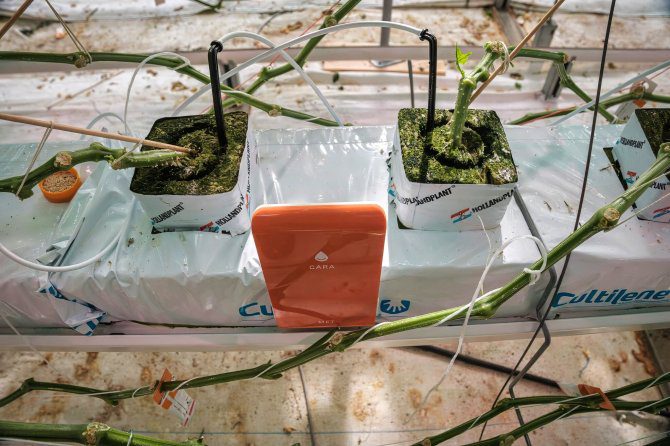TL;DR:
- AGROS validation trial achieves progress in autonomous greenhouse control.
- AI algorithm driven by Reinforcement Learning successfully manages greenhouse climate and crop growth.
- Digital Twin model demonstrates an objective control strategy based on real-time data.
- Reinforcement Learning algorithm pioneers full autonomy in a greenhouse compartment.
- Future focus includes integrating robust sensors for more data-driven control.
Main AI News:
The culmination of the AGROS validation trial marks a significant stride toward the achievement of a fully self-regulating greenhouse, as researchers successfully integrated cutting-edge technologies to oversee the growth of a thriving cucumber crop. This groundbreaking endeavor, centered on an AI algorithm rooted in Reinforcement Learning, stands as a beacon of innovation in the realm of agricultural automation.
Anja Dieleman, an esteemed figure leading the AGROS project and a dedicated researcher at Wageningen University & Research’s Greenhouse Horticulture division, shares a comprehensive overview of the triumphant validation trial and its consequential outcomes. “Over the past biennium, we meticulously laid the groundwork for the autonomous cultivation of cucumbers. This involved identifying pivotal plant traits guiding crop management and climate control decisions, as well as selecting the most fitting sensors for quantifying these traits,” elucidates Anja.
The pursuit of greenhouse autonomy entailed the development of two distinct algorithms: a mechanistic Digital Twin that relied on model-based insights and a machine learning mechanism hinging on Reinforcement Learning principles. Anja underscores that the commencement of the validation trial this year marked a pivotal juncture. These dual approaches, in tandem with a reference model based on grower expertise, were put to the test in a live greenhouse trial at WUR’s research facilities in Bleiswijk, the Netherlands.
The primary objective? To maximize net profit, an equilibrium is defined by the interplay between dynamic costs (comprising electricity, natural gas, and CO2 expenditure) and gains (hinging on harvested cucumber yields, contingent on fruit weight). On the symbolic date of May 11, the last of the cucumbers were reaped from the AGROS trial’s greenhouse compartments.
A Fusion of Tradition and Tech The heart of the ‘growers’ compartment’s climate control and crop management was steeped in time-tested grower wisdom, augmented by optimal practices. This entailed a meticulously premeditated cultivation and irrigation strategy aimed at fostering harmonious crop growth and productive output. Central to this strategy was the crop’s assimilate requirements, sourced from sunlight, supplementary LED lighting, and calibrated temperature and CO2 administration.
As the trial progressed, a pruning strategy was initiated upon the emergence of the initial flowers. This strategy was rooted in leaf count and projected light levels. The overarching aim was to cultivate a vigorous crop, with projected production offsetting the expenses linked to electricity, heat, and CO2. Anja underscores the precision of this strategy: “The actual harvest closely mirrored our yield predictions, originally formulated at the trial’s outset. This attests to the robustness of our approach. Notably, this control strategy yielded the highest net profit within the growers’ compartment.”
A Glimpse into the Future: The Digital Twin’s Dominance The Digital Twin, entrusted with the oversight of the second compartment, materialized through a fusion of crop and climate models at Greenhouse Horticulture. This Digital Twin, a realm mirroring reality, charted an optimal control strategy by factoring in responses from simulated climate data and a virtual cucumber crop.
Leveraging real-time inputs from climate sensors and manual crop assessments, the Digital Twin embraced a self-calibrating mechanism that honed its control strategy throughout the trial period. This strategy sought equilibrium between actual expenses and future benefits—the forthcoming two weeks’ worth of harvest. Although the cucumber harvest fell short of expectations, the Digital Twin adroitly harnessed fluctuations in electricity pricing, culminating in the most cost-effective utilization of kilowatt-hours. As Anja envisions, “The immediate horizon places the Digital Twin at the forefront of deploying autonomous cultivation in commercial contexts. Its aptitude to objectively navigate intricate greenhouse systems, balancing resource outlays with product valuations, is commendable.”
Forging Ahead with Reinforcement Learning The third compartment of the greenhouse boasted a climate regimen orchestrated by a Reinforcement Learning (RL) algorithm, itself trained on virtual datasets detailing cucumber crops and climatic conditions. Anja accentuates the pioneering nature of this endeavor: “AI’s role in greenhouse horticulture remains in its infancy, and this marks one of the initial instances where a greenhouse was exclusively managed by a Reinforcement Learning algorithm.”
Actuators such as lighting, screens, CO2 concentration, and heating were under the purview of this model, though irrigation and fruit pruning were excluded from its scope. Initially mirroring control tactics from the ‘growers’ compartment, the RL algorithm transitioned to independent control once fruits began to set. While this approach led to divergent greenhouse conditions compared to the other compartments, the crop exhibited remarkable resilience to temperature oscillations. Despite adhering to a pre-set fruit pruning strategy, impressive fruit production ensued.
Towards Sensory Synergy While the ultimate objective revolves around a sensor-driven ecosystem delivering continuous and empirical insights, the AGROS validation trial championed a measured approach. Control decisions drew from manual measurements to avert disruptions arising from system glitches. The next evolutionary step, as Anja elucidates, necessitates sensor integration into the control loop. This requires robust sensor solutions complemented by soft sensor-based methodologies, shaping a more seamless and proactive approach to greenhouse management.

Source: Guy Ackermans
Conclusion:
The AGROS trial underscores a pivotal shift towards autonomous greenhouse control through AI-powered algorithms. The success of Reinforcement Learning and Digital Twin models showcases the potential to optimize crop growth and resource management. As the horticultural sector faces challenges of expertise scarcity and rising costs, embracing such data-driven approaches could reshape the market, enabling more efficient and productive operations.

